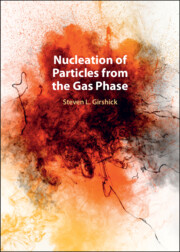Book contents
- Nucleation of Particles from the Gas Phase
- Reviews
- Nucleation of Particles from the Gas Phase
- Copyright page
- Dedication
- Contents
- Preface
- Symbols
- 1 Introduction
- 2 Single-Component Homogeneous Nucleation from a Supersaturated Vapor
- 3 Classical Nucleation Theory
- 4 Classical Theory of Multicomponent Nucleation
- 5 Classical Theory of Ion-Induced Nucleation
- 6 Atomistic Approaches to Homogeneous Nucleation
- 7 Transient Nucleation
- 8 Chemical Nucleation
- 9 Nucleation in Plasmas
- References
- Index
4 - Classical Theory of Multicomponent Nucleation
Published online by Cambridge University Press: 30 May 2024
- Nucleation of Particles from the Gas Phase
- Reviews
- Nucleation of Particles from the Gas Phase
- Copyright page
- Dedication
- Contents
- Preface
- Symbols
- 1 Introduction
- 2 Single-Component Homogeneous Nucleation from a Supersaturated Vapor
- 3 Classical Nucleation Theory
- 4 Classical Theory of Multicomponent Nucleation
- 5 Classical Theory of Ion-Induced Nucleation
- 6 Atomistic Approaches to Homogeneous Nucleation
- 7 Transient Nucleation
- 8 Chemical Nucleation
- 9 Nucleation in Plasmas
- References
- Index
Summary
The classical theory of multicomponent nucleation, including binary nucleation, ternary nucleation, etc., makes similar key assumptions as in CNT for single-component nucleation. Clusters are modeled as spherical liquid droplets consisting of an ideal multicomponent solution. The surface tension is assumed to equal that of a flat surface of liquid having the same composition, in equilibrium with its multicomponent vapor. The Gibbs free energy of cluster formation is a function of the cluster’s size and composition and of the gas-phase partial pressures of each component. The critical size and composition are found at a saddle point on the multidimensional free energy surface, where the free energy of cluster formation is a maximum in one direction and a minimum in all orthogonal directions. Several improvements have been proposed within the framework of classical theory. These include models of the cluster growth trajectory near the critical point; studies that account for composition-dependent surface tension; and models that consider the existence of surface-active layers that cause the chemical composition near the cluster surface to be different than in the core.
Keywords
Information
- Type
- Chapter
- Information
- Nucleation of Particles from the Gas Phase , pp. 94 - 106Publisher: Cambridge University PressPrint publication year: 2024
